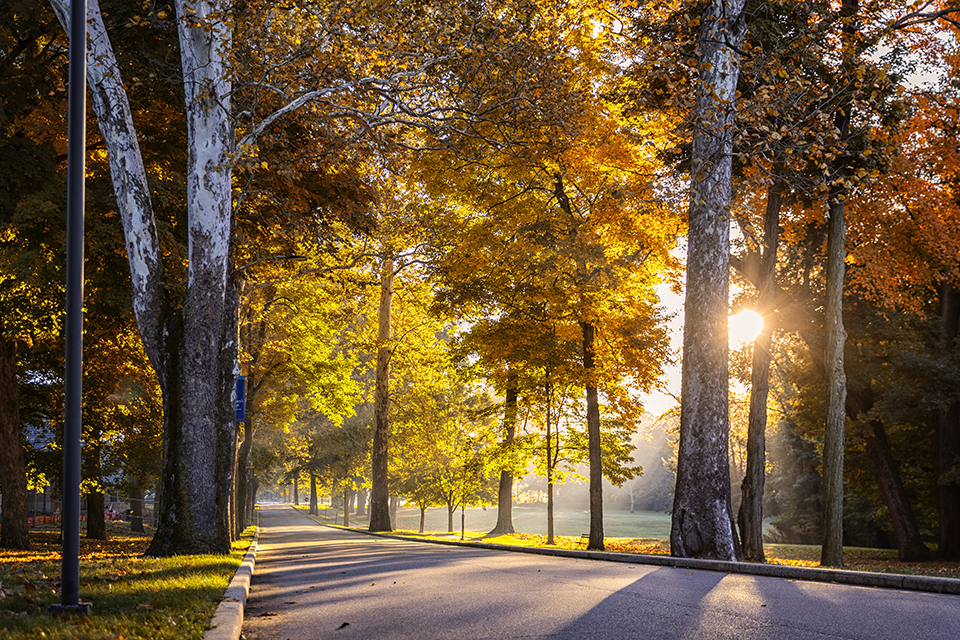A Song for Autumn
Dear Saint Mary’s Friends,

These October days, the campus has been aglow with maples and sycamores shimmering in flame and gusty winds sending showers of colorful leaves across The Avenue. The willows around Lake Marian are yellowing and growing gradually thinner. Walking to the library or the student center, or even just looking out my windows in Le Mans Hall, I see the burnished ivy on Moreau Hall or the intensity of the redbud trees, and I can almost feel the world turning.
A few days ago, I turned the leaves of a favorite book—Devotions: The Selected Poems of Mary Oliver—in search of some of her inspiring fall poems. Oliver’s exhortations to look and to listen, to slow down and pay attention, always speak to something in me. And on this occasion, her poem “Song for Autumn” did just that. In it, she invites us to imagine that the falling leaves themselves are dreaming “how / comfortable it will be to touch / the earth instead of the / nothingness of the air and the endless / freshets of wind.” The poem pictures the leaves’ anticipation and surrender—both of which are required to move gracefully from one season to the next. There’s a lesson in that.
In fact, this time of year always reminds me of the many ways that the College, too, lives by a rhythm of seasons. We see it most clearly in our undergraduate students, whose four years unfold like a cycle of spring, summer, autumn, and winter—times of arrival and growth, of fullness and letting go. Seasons at the College are also measured across generations: each one brings change and renewal, yet each one is grounded in the same deep roots of learning, faith, community, and justice that have sustained Saint Mary’s for over 180 years.
This year, we mark a special milestone: the 100th anniversary of Le Mans Hall. Its walls have watched a century of Saint Mary’s seasons—students carrying books and hopes across the various greens, Sisters, as well as lay faculty and staff, encouraging lives of purpose. Le Mans is not the oldest building on campus, but it is our campus centerpiece, and it stands as a symbol of constancy in the midst of change, reminding us that the heart of Saint Mary’s endures even as the College grows and adapts.
I’ve felt that continuity in small, unexpected ways lately. As we completed some long-overdue updates to the President’s Office suite, I unpacked boxes of books and files I inherited when I arrived here in 2020 that had been tucked away for years. Inside, I found published lectures and talks from decades past—reflections from faculty (many now retired) and visiting scholars whose ideas once filled our classrooms and auditoriums. Some of those lecture series still continue, like the Francis A. McAnaney Humanities Lecture (formerly the Christian Culture Lecture) which welcomed novelist and poet Julia Alvarez to campus this month—or the Madeleva Lecture which takes place each spring. Others have grown up alongside these. But together they tell a story that stretches across generations—a story of our rootedness in a mission to “promote a life of intellectual vigor, aesthetic appreciation, religious sensibility, and social responsibility.”
Every falling leaf becomes part of the soil that nourishes next spring’s growth. We understand this cycle, even if a leaf doesn’t. If we pay attention, we can also see that pattern in every student who passes through Saint Mary’s, every class taught, every guest speaker, every friendship formed: these add to the living richness of this place. Nature can remind us that change and constancy, renewal and remembrance are not opposites, but partners in a rhythm—the rhythm of the life of the College and of the lives it shapes. Another autumn poem from Mary Oliver, “Lines Written in the Days of Growing Darkness,” considers how we witness this seasonal turn every year and how we absorb it. We may not want to accept the end of what she calls “the sweets of the year,” but we can wait for new beginnings. So I ask, with Oliver, “who would cry out / to the petals on the ground/ to stay, / knowing, as we must, / how the vivacity of what was is married / to the vitality of what will be?”
I know I’ll be reflecting on how, in my own personal seasons as well as in the seasons of the College, past vivacity and future vitality are linked. I invite you to pause along with me, maybe even to read a fall poem or two, and to ask yourselves: What will I let go of? What will I renew? How will I contribute to the next season of Saint Mary’s?
October 31, 2025
